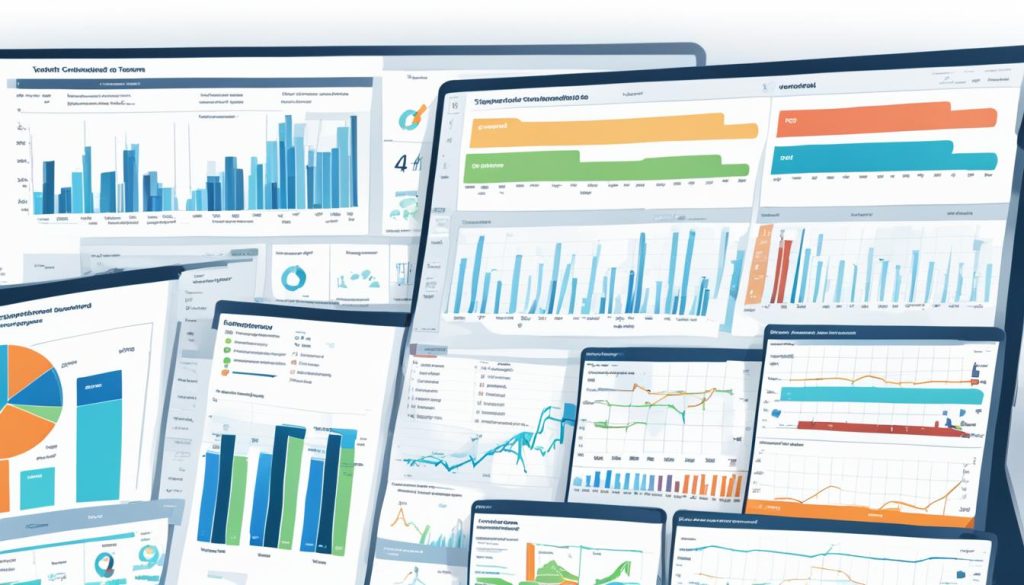To train your HVAC team on load calculation software well, use a structured plan. This plan should mix hands-on practice with learning the theory. Begin by picking software that is easy to use and meets your team’s needs. Then, teach them its features through interactive sessions.
Start your team’s software training by showing them why load calculations are key in designing systems and saving energy. Focus on how they can use the software in real situations. This way, they’ll learn fast and use the software well in their jobs.
For better skill growth, pair experienced team members with new ones. This helps speed up learning and builds teamwork. Regular checks and feedback will show how well they’re doing and help solve any software issues.
Understanding the Importance of Load Calculation Software in HVAC
HVAC load calculation software is key in today’s heating, ventilation, and air conditioning systems. It helps experts design systems that fit building needs well. Let’s see why this software is vital for HVAC pros.
Benefits of Accurate Load Calculations
Precise HVAC load calculations bring many benefits:
- Proper equipment sizing
- Reduced energy consumption
- Improved indoor comfort
- Lower installation and operating costs
Impact on Energy Efficiency and Customer Satisfaction
Right load calculations boost energy efficiency and make customers happy. By picking the right system size, HVAC pros can:
- Minimize energy waste
- Cut clients’ utility bills
- Boost indoor comfort
- Make systems last longer
Role in Optimizing HVAC System Design
Load calculation software is crucial for designing HVAC systems well. It lets pros:
- Consider building materials and insulation
- Look at local climate
- Use occupancy patterns
- Plan ductwork and airflow right
| Feature | Benefit |
|---|---|
| ASHRAE design conditions | Current climate data for precise calculations |
| Pre-configured assemblies | Quick options for common designs |
| Custom designs | Flexibility for unique projects |
| Thermal mass calculations | Better accuracy for efficient designs |
Using these features, HVAC pros can make systems that save energy, please customers, and work great in different buildings.
Selecting the Right Load Calculation Software for Your Team
Finding the best HVAC software is key for accurate load calculations and efficient system design. We’ll look at important features, compare top choices, and think about ease of use. This will help you make a smart choice.
Key features to look for in HVAC load calculation software
When checking out HVAC software, focus on these must-haves:
- Advanced algorithms for precise load computations
- Consideration of building factors (size, orientation, insulation)
- Local climate data integration
- Customizable options for different project types
- Robust error-checking capabilities
- Energy conservation and sustainability features
- Integration with BIM and energy modeling tools
Comparing popular software options
Comparing load calculation software can help you pick the best for your team. Here’s a brief look at some top choices:
| Software | Key Features | User-Friendliness | Integration |
|---|---|---|---|
| HVAC-Calc | Accurate algorithms, climate data | Intuitive interface | Limited BIM integration |
| CoolCalc | Energy modeling, customization | Moderate learning curve | Strong BIM compatibility |
| LoadPro | Sustainability focus, error-checking | User-friendly design | Comprehensive integration |
Considering user-friendliness and learning curve
Choose user-friendly HVAC software for quick adoption and consistent use by your team. Look for easy interfaces, good training resources, and fast customer support. A software with a steeper learning curve might be better if your projects need advanced features.
Preparing Your HVAC Team for Software Training
Getting your HVAC team ready for software training is key. You must build a strong foundation for their skill growth. This means taking a few important steps to make sure they’re ready for new software and can grow their skills.
First, check what your team knows and can do. This helps you see where they might need extra help with the software. You can do this by giving surveys or talking one-on-one to find out how comfortable they are with technology and what they need to learn.
Then, make a detailed training plan. It should cover the goals and what you want to achieve with the new software. Include a timeline for learning and how you’ll track progress. Make sure to share this with your team so everyone knows what’s expected.
Essential Elements of HVAC Software Training Preparation
- Skill assessment
- Goal setting
- Timeline creation
- Resource allocation
- Team communication
Choosing “software champions” in your team can make the transition smoother. These people can help their colleagues during training and later on. A supportive environment encourages team members to accept the new software and see how it can help their work.
| Training Component | Purpose | Expected Outcome |
|---|---|---|
| Software Overview | Introduce basic functionality | Familiarity with interface |
| Hands-on Exercises | Practice real-world scenarios | Improved confidence in usage |
| Q&A Sessions | Address individual concerns | Clarification of doubts |
| Progress Assessments | Evaluate learning effectiveness | Identification of areas for improvement |
Putting effort into preparing your HVAC team sets the stage for successful software training and ongoing skill growth. This careful planning helps your team adjust to new tech better and boosts their performance in their work.
Train Your Team Efficiently on Software
Creating a strong HVAC software training program is key to your team’s success. Focus on structured learning, hands-on experience, and mentorship. This way, your staff will quickly become experts in load calculation software.
Developing a Structured Training Program
Make a detailed HVAC software training program that covers everything about load calculation. Break the training into modules, each focusing on a specific software feature. This method lets your team learn step by step, gaining confidence and skills gradually.
Utilizing Hands-On Exercises
Add hands-on HVAC training exercises using real-world scenarios. This practical method helps your team use their knowledge in real situations they’ll face. Set up mock projects for them to practice load calculations on different buildings and HVAC systems.
Implementing a Mentorship System
Start an HVAC mentorship program for ongoing learning. Pair experienced team members with new ones for guidance and questions. This one-on-one support speeds up learning and builds team spirit.
| Training Component | Benefits |
|---|---|
| Structured Program | Systematic learning, clear progression |
| Hands-On Exercises | Practical skills, real-world application |
| Mentorship System | Personalized support, knowledge sharing |
By combining these elements, you make a strong training environment. It prepares your team for HVAC load calculations. Always check in regularly to see how they’re doing and help with any challenges they face.
Leveraging Interactive Learning Tools and Resources
HVAC interactive learning tools change how you train your team on load calculation software. These tools make learning complex concepts fun and easy. They help your team understand and use these concepts in real situations. Adding HVAC e-learning to your training means better retention and quicker skill growth for your staff.
On-demand webinars are a great tool for your team. They focus on topics like heating and cooling load calculations. This lets team members learn at their own speed. Plus, software training resources often have interactive simulations. These simulations let your team practice with real HVAC systems safely.
Let’s look at some top HVAC interactive learning tools:
| Tool Type | Benefits | Best For |
|---|---|---|
| Virtual Reality Simulations | Immersive learning experience | Equipment sizing practice |
| Interactive Quizzes | Immediate feedback on knowledge retention | Load calculation principles |
| Video Tutorials | Visual demonstrations of software features | Step-by-step software walkthroughs |
| Mobile Learning Apps | On-the-go access to training materials | Quick reference guides |
Using these HVAC e-learning tools can really improve your team’s skills with load calculation software. Make sure to pick tools that fit your software and team needs for the best outcomes.
Addressing Common Challenges in Software Adoption
HVAC software adoption can be tough. Your team might resist change or face technical issues. Let’s look at how to beat these challenges and make sure your HVAC team uses the software well.
Breaking Down Resistance
Change can be daunting. Some might worry about learning new systems or fear losing their jobs. To calm these fears, point out the perks of load calculation software. Explain how it simplifies and improves their work. Offer personalized help to those who need it.

Tackling Technical Troubles
Fixing technical problems is vital for smooth software adoption. Create a support system for your team. This could be an in-house expert or a direct contact with the software company. Fast problem-solving reduces stress and keeps work flowing.
Keeping Usage Consistent
It’s important to keep the team using the software consistently. Make rules clear on when and how to use it. Regular meetings can spot problems early. Think about rewarding team members who use the software right.
| Challenge | Solution |
|---|---|
| Resistance to change | Highlight benefits, provide individual support |
| Technical difficulties | Set up dedicated support system |
| Inconsistent usage | Create clear guidelines, regular check-ins |
By tackling these common challenges, you’ll make the way smoother for HVAC software adoption. Remember, patience and ongoing support are crucial. They help overcome hurdles and enjoy the benefits of your new load calculation software.
Integrating Load Calculation Software with Existing HVAC Processes
HVAC software integration is crucial for making HVAC processes more efficient. By adding load calculation integration to your current workflow, you’ll see big improvements in both field and office work.
Begin by linking your load calculation software with dispatch tools. This connection helps with smarter scheduling and routing. Your technicians will travel less and help more customers. You’ll also easily track their work and find ways to get better.
Then, work on improving how you talk to customers. Many HVAC software tools have features that keep customers updated. Automated messages about when they’ll be visited, the job’s progress, and when it’s done can make customers happier.
| Integration Type | Benefits |
|---|---|
| Energy Modeling Software | Accurate energy consumption predictions |
| CAD Software | Precise system design and layout |
| Project Management Tools | Improved task tracking and resource allocation |
Think about adding your load calculation software to other strong tools. Energy modeling software can predict energy use better. CAD software helps with exact system designs. And, project management tools make tracking tasks and resources easier.
Remember, making HVAC software work together is a process. Start with just one or two key connections. As your team gets used to it, add more systems. This way, you can use load calculation integration fully without stressing your team.
Measuring and Tracking Training Progress
It’s key to keep an eye on your HVAC team’s progress with load calculation software. A good system for measuring and tracking their learning helps them make the most of their training.
Setting Clear Performance Metrics
First, set up HVAC training metrics that match your goals. These could be:
- Time taken to complete load calculations
- Accuracy of results compared to manual calculations
- Number of projects completed using the software
- Customer satisfaction ratings on projects using software-based calculations

Conducting Regular Assessments
Do regular performance assessments to see how your team is doing. This could mean:
- Quarterly software proficiency tests
- Peer reviews of completed load calculations
- On-site observations of software usage during client visits
Providing Feedback and Support
Use your assessments to give constructive training feedback. Have one-on-one meetings to talk about what needs work and what’s going well. Offer more help through:
- Refresher courses on tricky software features
- Mentoring sessions with seasoned team members
- Access to online tutorials and resources
By always checking on progress and offering support, you’ll help your HVAC team keep getting better at using load calculation software.
Continuous Improvement and Software Updates
HVAC software updates are key to keeping your tools up-to-date and effective. It’s important to stay on top of these updates. This ensures your team gets the latest features and improvements. Let’s look at how to manage this process well.
Most HVAC load calculation software gets updates every three months. These updates bring new features, better functions, and fixes for bugs. To use these updates well:
- Set up automatic notifications for software updates
- Review release notes to understand new features
- Schedule team training sessions for major updates
- Encourage team members to explore new functionalities
Improving your HVAC processes depends on software updates and team feedback. Make a system for staff to report issues, suggest improvements, and share their software experiences. This feedback helps with training and choosing future software.
Regular software maintenance is key for the best performance. Check regularly to make sure all devices have the latest version. This stops compatibility problems and makes sure everyone uses the newest tools.
The aim of keeping up with HVAC software updates is to make your team more efficient and accurate in load calculations. By focusing on continuous improvement and regular software maintenance, you’ll keep your HVAC operations leading in the industry.
Conclusion
Training your HVAC team on load calculation software changes the game for your business. By investing in this training, you’ll see a big boost in efficiency and team performance. Your technicians will make more accurate calculations, leading to better system designs and more energy efficiency.
Improving your team’s skills goes beyond just technical knowledge. As they get better with the software, they’ll work faster and with more confidence. This means happier customers and possibly more business for your company.
For a successful change, start with the right software and prepare your team well. Use interactive learning tools and tackle challenges as they come. Make sure the new processes fit smoothly into your current operations. With ongoing support and updates, you’ll keep your team leading the way in the industry.
By focusing on load calculation efficiency through strong software training, you’re not just improving now. You’re preparing your business for the future. The skills your team learns will be crucial as the HVAC industry changes, keeping your company ahead in a competitive market.





0 Comments